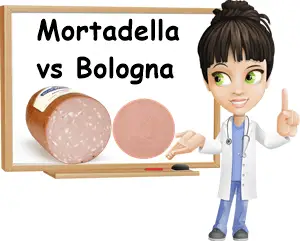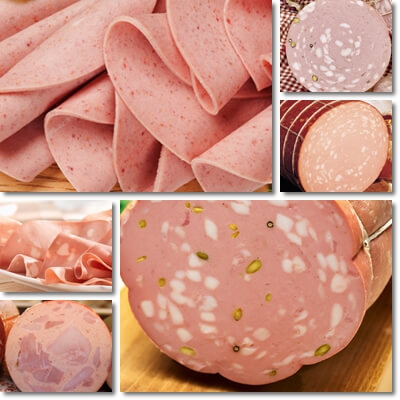What is the difference between mortadella and bologna? Is there even a difference or are mortadella and bologna the same thing? Can you tell the difference between mortadella and bologna based on how they look and taste? Is all mortadella the same? Is all bologna the same? And finally, which is the original luncheon meat between the two and which is a copycat?
What is mortadella?
Mortadella is a traditional Italian luncheon meat. It is also officially known as Mortadella Bologna and, unofficially, as mortadella meat or, more rarely, mortadella ham. Mortadella is a delicacy with Protected Geographical Indication status (PGI) or Indicazione Geografica Protetta (IGP). Having protected status under EU law is a recognition of both its superior quality and origin, meaning real mortadella is not the same thing as bologna.

What is bologna?
Bologna or baloney is a chiefly US sausage-type of luncheon meat. It’s also commonly referred to as ‘bologna sausage’ because of its sausage-like appearance. It’s not a traditional Italian specialty like mortadella, but rather a cheaper luncheon meat version. The names bologna and bologna sausage are believed to be derived from the official name for mortadella, Mortadella Bologna. In addition to American bologna, there are other mortadella-inspired luncheon meats such as parizer, pariser, polony, Lyoner or jumbo.
Mortadella vs bologna: differences
Can you name the differences between authentic mortadella and the American mortadella-like bologna or baloney? It can get tricky since the two are very similar-looking. Here is a thorough comparison between mortadella and bologna to help you tell the difference like you’ve been eating them your whole life:

Ingredients in mortadella vs bologna
Authentic Italian mortadella is made exclusively from pork meat and pork neck fat, seasoned with black peppercorns, salt and myrtle berries, as per the original recipe. Other ingredients include spices such as cloves, caraway, nutmeg, cinnamon, garlic, coriander, anise etc., nuts and seeds such as pistachios or pine nuts, fruits such as olives, chili peppers or pepperoncini, even wine.
American bologna can be made from any type of meat, most notably pork, beef, veal, lamb, turkey, chicken, venison and other game, with the addition of varying amounts of fat. In fact, bologna may contain different types of meat in varying ratios. Spices include: black pepper, salt, myrtle berries, cloves, anise, caraway, coriander, marjoram, paprika, allspice and other spices and ingredients typically used in mortadella, to reproduce the taste of mortadella.
What is mortadella made of vs bologna?
Authentic, traditional Italian mortadella is made exclusively from finely ground pork meat, with the addition of visible chunks of pork neck fat. Ingredients are of the highest quality and spices carefully selected.
Mortadella contains nitrites and nitrates, both of which occur naturally as a result of the curing process, and can be added for a longer shelf life.
Find out all about the side effects and benefits of mortadella, with detailed nutritional information values.
What is bologna made of?
Bologna can be made of different types of meat, from pork to beef, veal, lamb, turkey, chicken and even venison and other game.
It can be made of either higher quality meat parts (such as leg, shoulder, belly, neck) or miscellaneous parts (essentially meat scraps left over from the production of other, higher-end meat products). Spices are carefully selected to mimic the taste of mortadella.
Commercial bologna is also more likely to contain various additives such as soy protein, dextrose, monosodium glutamate (MSG), stabilizers, preservatives (sodium nitrate, sodium diphosphates such as disodium diphosphate), but also ascorbic acid and milk proteins, milk solids, even flour and various grains. The lower the price, the lower the quality of the ingredients used, or the lower the ratio of meat to vegetal ingredients.
How is mortadella made vs bologna?
Mortadella is made by finely grinding lean, high-quality pork meat seasoned with a selection of spices, then mixing in chunks of pork neck fat and possibly also other ingredients such as pistachios, peppers or green olives. It’s then pressed and bagged in an inedible casing.
Mortadella is tied with string to help it retain its sausage-like shape and hung in hot air driers to cook for several hours or days, depending on how big it is. While authentic Italian mortadella is typically a cured and cooked luncheon meat, there are variations of smoked mortadella too, or dry or semi-dry variations. Bologna is made in a similar manner, the difference being the choice and sometimes also quality of ingredients used.
Are mortadella and bologna cooked or cured?
Both mortadella and bologna are cured AND cooked luncheon meats. How’s that? Both mortadella and bologna contain nitrites and nitrates which account for the cured part.
These form naturally in the products, but are also intentionally added to increase shelf life and prevent spoilage. Granted, bologna tends to have more, especially if it’s on the cheaper side.
Mortadella and bologna are also typically cooked, hence their prosciutto cotto-like taste and the beautiful pink color and soft texture of the meat.
Of course, there are smoked and dried versions, but these are variations of the original recipe.
Mortadella vs bologna: appearance
What does mortadella look like? What does bologna look like?
Both mortadella and bologna look like giant sausages: long, round or oval, heavy-set rolls of ground meat encased in an usually inedible membrane.
But the difference is mortadella is usually a lot larger in diameter than bologna, and a healthy pink color with visible chunks of fat disposed in an irregular pattern. Whereas bologna typically has no visible fat (just finely ground meat).
Also, the color of bologna may range according to the type of meat used. Game, venison will be a grayish-brown, beef, lamb and turkey should be pink-red, whereas chicken or soy bologna are a lot lighter colored, a pale pink. Mortadella is available in various sizes ranging from a few kilograms to a few dozens of kilograms, whereas bologna is usually a lot smaller.
Mortadella vs bologna: taste
Some people say mortadella and bologna taste the same. They may be right, depending on what mortadella and bologna they have tried. But I would have to disagree on this – I don’t feel mortadella and bologna taste the same. Considering that even the slightest change in ingredients, whether amounts of certain ingredients or choice of ingredients, determines more or less noticeable differences in taste, it’s unlikely for two different foods to taste exactly the same when they have different ingredients and also different amounts of the same ingredients.
Agreed that taste perception ranges greatly between people, with some people being able to better perceive the unique flavor notes in various foods vs others. Still, real mortadella generally does not taste the same as bologna.
What does mortadella taste like? What does bologna taste like?
Authentic Italian mortadella has a finer taste than bologna: delicate pork flavors and a soft and smooth, velvety texture with the richness of pork fat chunks. Extra ingredients in mortadella, such as green olives or pistachios, add a pleasant crunchiness to the smooth meat, and extra flavors that compliment the delicate heaviness of the pork meat and fat. Bologna can be made of superior ingredients and taste good, but there will be a noticeable difference in taste if other meats than pork are used. While spices are selected to mimic the taste of mortadella, you can usually tell the difference between bologna and mortadella if you’ve eaten both at least a few times.
Is mortadella healthy or bologna healthier?
While mortadella is generally healthier than bologna, neither are very healthy foods considering they are both cold cuts or deli meats which implies various degrees of processing and often also the use of preservatives. There are definitely a lot healthier meat products out there, namely unprocessed meat such as chicken drumsticks, turkey breast, ground beef etc. Wholly unprocessed meat is as healthy as meat gets, but that doesn’t mean there aren’t any benefits to eating mortadella or bologna.
For one, both cold cuts are made from meat, pork, and other types of meat in the case of bologna, and should provide relatively good nutrition.
Vitamin and mineral profiles indicate a good to high B vitamin content, and a similar content of iron, phosphorus, potassium, selenium, zinc and choline, among other essential nutrients.
Other nutrients are also available from the extra ingredients in mortadella and bologna, such as green olives, pistachios or peppers which add to the nutrition value of the two luncheon meats.
Let’s just say that there are a lot worse foods to eat than mortadella and bologna.
The main disadvantage is that both mortadella and bologna are cured lunch meats and contain additives and preservatives such as nitrites and nitrates, which are definitely not healthy. Both mortadella and bologna also have lots of sodium and a high content of fat, especially saturated fat. However, there are around 10-20 g of protein in addition to the average 20-25 g of fat in mortadella and bologna, depending on the recipe used, with mortadella usually being on the higher side in protein, and fat, content.
One of the biggest side effects of eating mortadella and even bologna is a risk of allergic reactions since both mortadella and bologna may contain one or more common allergens: pistachios, various spices, peppers, milk proteins, milk solids etc.
Conclusion
Except for allergies, in which case consumption is absolutely not recommended, eating mortadella or bologna from time to time is not the worst thing you can do to your health. Occasional consumption characterized by a moderate intake should not be a source of major side effects for health, despite both being cured meats.
Instead both lunch meats should provide good nutrition and actively and measurably contribute to nutritional status, with immediate and long-term benefits for health such as higher energy levels, satiation, and even immune system support, support for intellectual effort and cognitive functions and more.
The nutrition of both mortadella and bologna can support the health of multiple systems and organs, providing benefits for skin health, bones, teeth, the cardiovascular, nervous and even immune system. Ideally, choose certified mortadella or a higher quality bologna and absolutely check the ingredients list to help you decide if what you’re getting is a quality food product.
